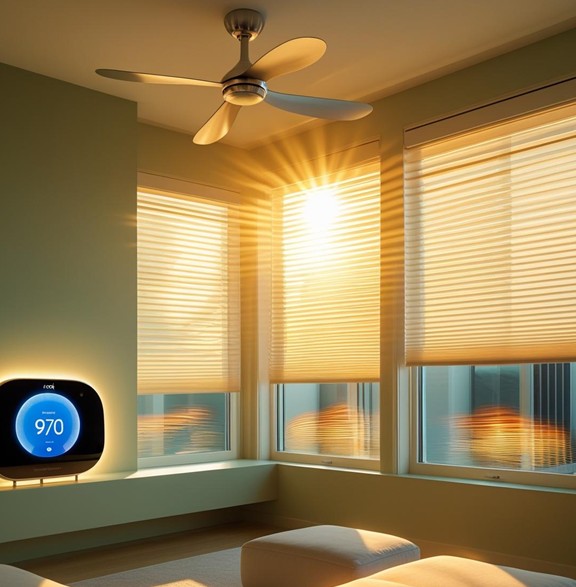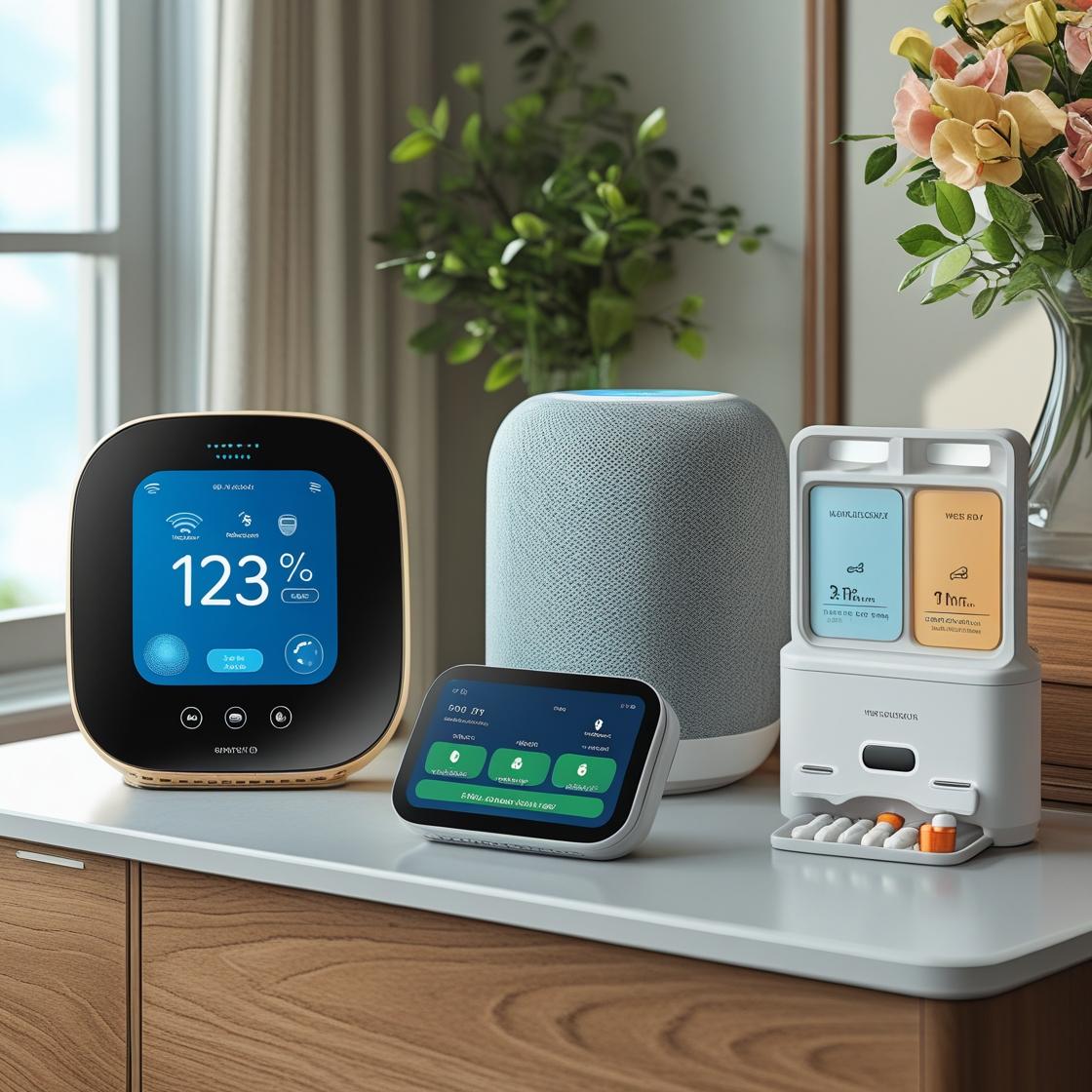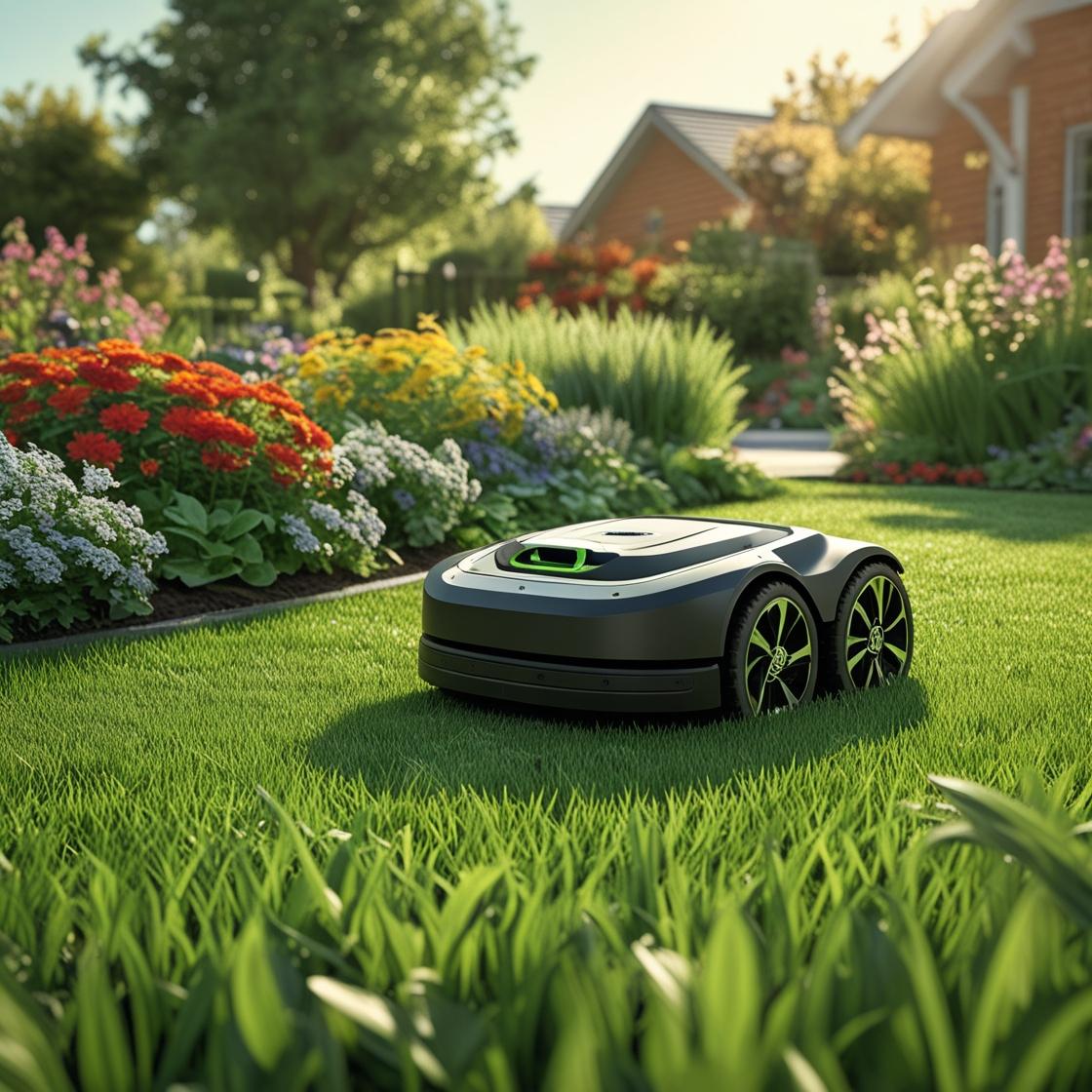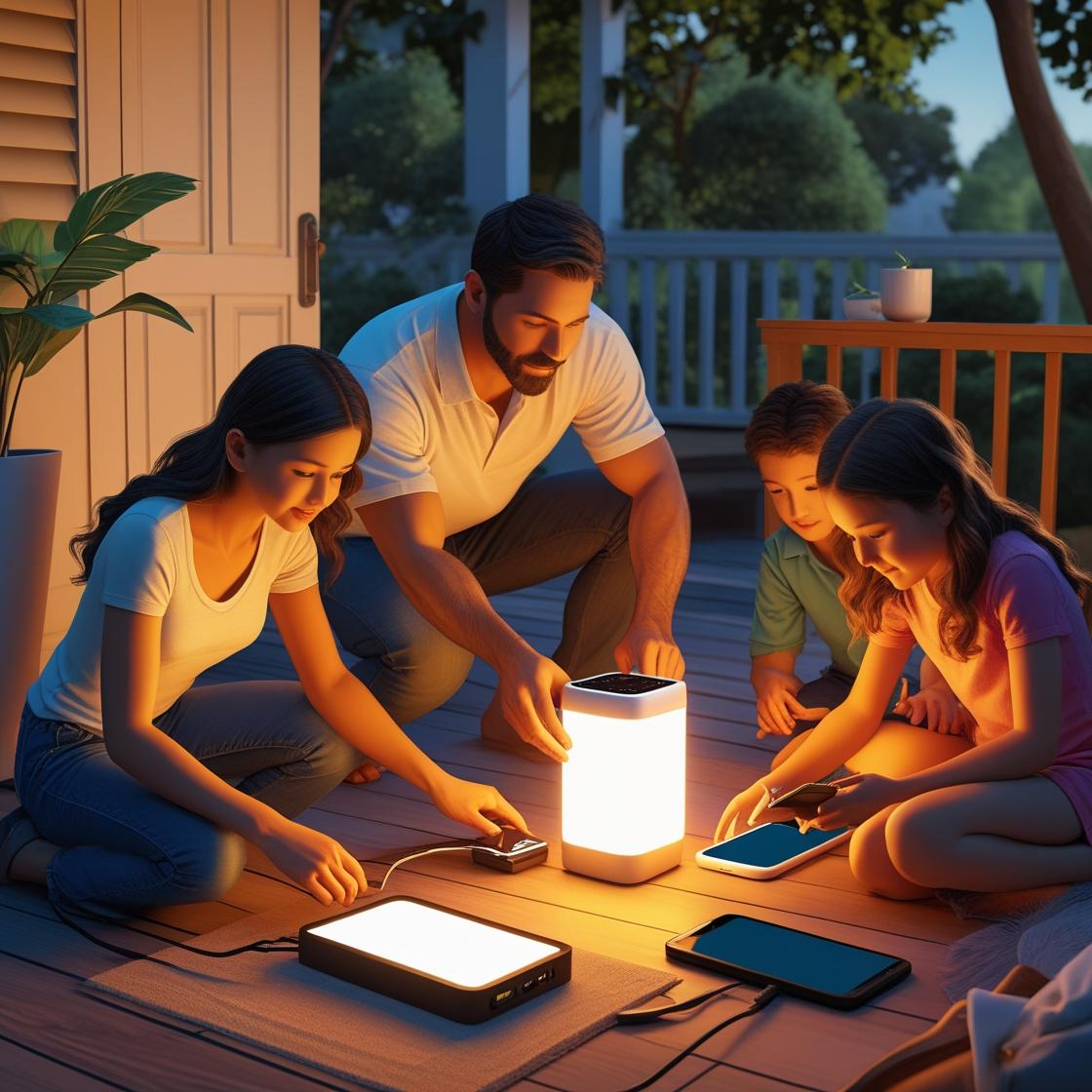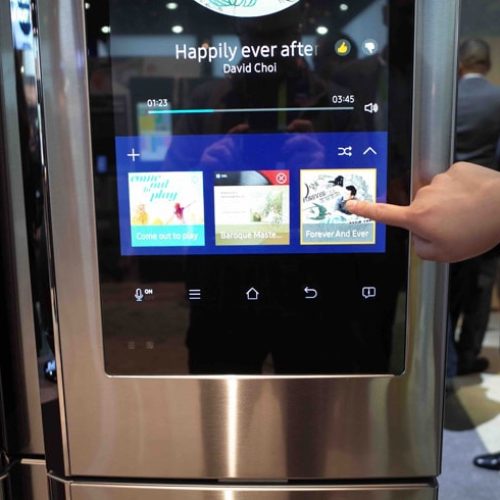The best smart refrigerators are still considered premium products these days, with a price point of several thousand dollars. They’ll probably decrease in price in the near future and become more accessible to the general public just like other smart home devices. If you are ready to make the investment and enjoy all the comfort a smart fridge has to offer let’s see which one is the best for you!
Our top pick has a large screen for looking inside and managing systems, as well as two drawer compartments for colder items. We like the two-drawer setup because it’s ultimately more practical for organizing things.
However, there isn’t that much difference between top-end refrigerators. To be honest, even the best smart refrigerator only has a few areas to distinguish itself from the competition. That’s common in mature technologies, so there are several other options worth considering.
Keep reading to learn more about the best smart refrigerator options.
#1 – LG LRMVC2306S
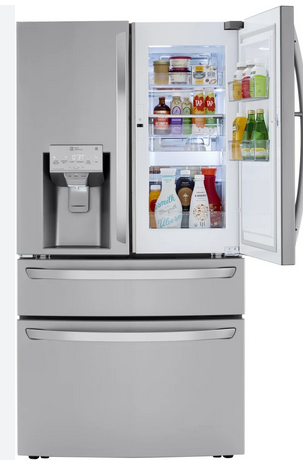
LG’s LRMVC2306S is a 23 cubic-foot fridge with a French Door design. The matte finish works well in most modern kitchens, while its hefty 404-lb weight helps ensure it won’t shift around while you’re using it. At counter-depth for sizing, it will also fit into most fridge areas with no trouble, but measure the 38 inches needed and try to leave a little room on the sides.
All of that’s good but hardly unique for any fridge. You don’t get to win the top spot just by being a functional product in your category, however well you do that. What sets this product apart from most of its competitors is the massive door-in-door screen and the decision to use two drawers on the bottom half instead of one.
The door-in-door panel illuminates with two quick taps, allowing you to look inside your fridge without opening it. That helps save energy and keeps food fresher for as long as possible. The smart systems include communication with other devices and an analysis system that studies your habits to help anticipate your temperature and ice needs.
Meanwhile, the smaller top drawer provides ready access to things without having to reach all the way down into the primary drawer. It’s a practical design that ultimately makes this an excellent choice for most households. Even better, the flexible drawer has settings that range from chilling wine to freezing the contents, so it can be whatever you want it to be.
Pros:
- Ergonomic design provides easy access to the things you want to get fast
- It has an outstanding ice maker
- The flexible drawer can match any family’s needs
Cons:
- More expensive than many competitors
- Less interior space than some other fridges
#2 – GE Profile PVD28BYNFS
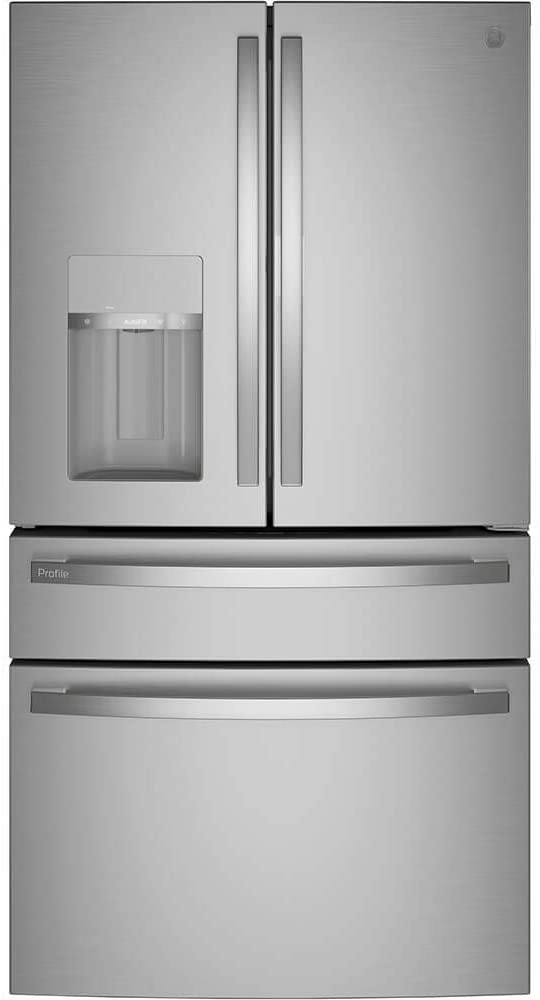
GE Profile PVD28BYNFS
GE’s PVD28BYNFS is a 27.6-cubic foot fridge that looks quite similar to my top choice at first glance. It nearly earned that title, but it lost out since it lacks the handy view glass for peeking inside without opening the door.
This fridge is all about convenience, starting with a hands-free autofill system for its water dispenser. The water goes through a filter inside the fridge for purity, though you’ll have to get GE’s branded filters as needed, or the system won’t work. Meanwhile, a convenient rotating bin makes it easier to store items like wine bottles.
Built-in Wi-Fi connections in this fridge connect to an app, allowing you to customize the brightness of the LED panels and enable turbo cooling and freezing settings if you need to chill something quickly. Overall, this is a solid example of a smart fridge without a window or screen on the front.
Pros:
- Highly functional design
- Detects frequent door openings to adjust efficiency as needed
- LED-lit back wall provides consistent light throughout the fridge
Cons:
- No window or control panel
- Short one-year warranty on the entire appliance
#3 – Samsung Family Hub 4-Door

This is an unusual design for fridges, which means it instantly stands out among competitors. This fridge offers three compartments. The top half of the fridge is one large compartment suitable for bigger, longer items, while the bottom half has separate chambers that you can set to different temperatures.
This gives more control over the temperature of each fridge section than most competitors offer. Still, you may be in trouble if you need to store something at freezing temperatures that’s wider than the compartment. Its smart door features are also more immediately apparent than other fridges, so if that’s what you want, this is a good place to start.
Unlike my first choice, this refrigerator is truly smart, complete with a large touchscreen display that can do everything from displaying the interior to letting you install and use various apps. In many ways, the screen functions as a giant tablet, exemplifying what a smart fridge can be.
Pros:
- Touchscreen display
- More functions than most competitors
- Flexible four-door configuration
Cons:
- More expensive than most competitors
- Some build quality issues
#4 – Samsung Side-By-Side Family Hub
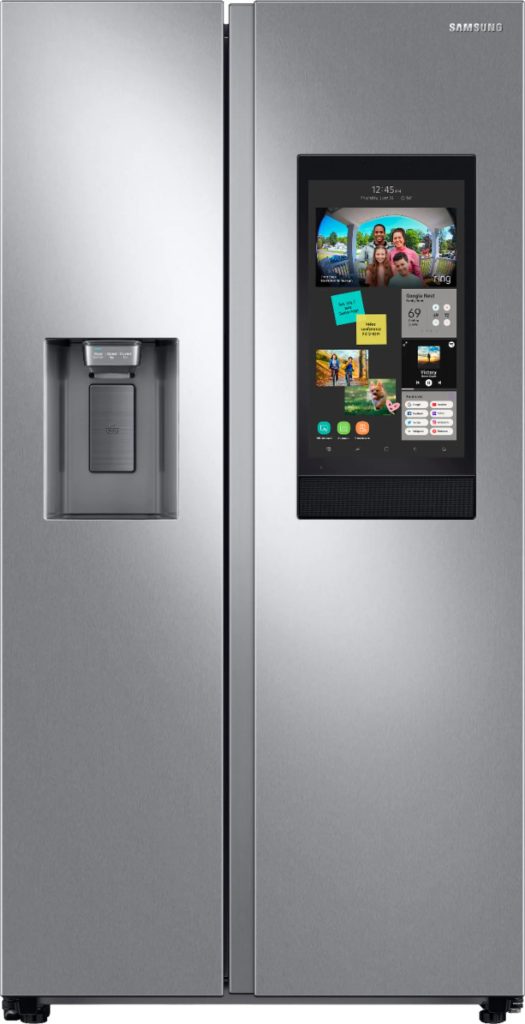
SAMSUNG RS23A500ASR side by side freestanding refrigerator
- Dimensions: 75.00 x 37.00 x 30.00 Inches
- Capacity: 22.6 Cubic Feet
This is similar to the previous choice, complete with the same massive touchscreen on the right-hand side and an excellent water/ice dispenser on the left. However, rather than being a three-compartment fridge with four doors, this model has just two doors for fridge and freezer sections. In practice, this means more freezer space and less fridge space.
I don’t like this quite as much as the four-door option, despite the significantly lower price. However, my dislike has less to do with any technology or features and more to do with the overall design. This is a very vertical fridge, which means it’s useful for storing small and tall items, but not anything that’s wide.
For example, you might struggle to fit some pizzas in this fridge before you cook them. Large baked dishes may also be too wide for the compartments here. That’s not an issue for all households, though. If you don’t mind the smaller shelves, this is an outstandingly affordable alternative to Samsung’s four-door option.
Pros:
- More affordable than most other smart fridges
- Lots of freezer space
- Fully-integrated touchscreen display
Cons:
- Not a good choice for storing large items
- Customer service can be hard to work with
#5 – Cafe Platinum Glass
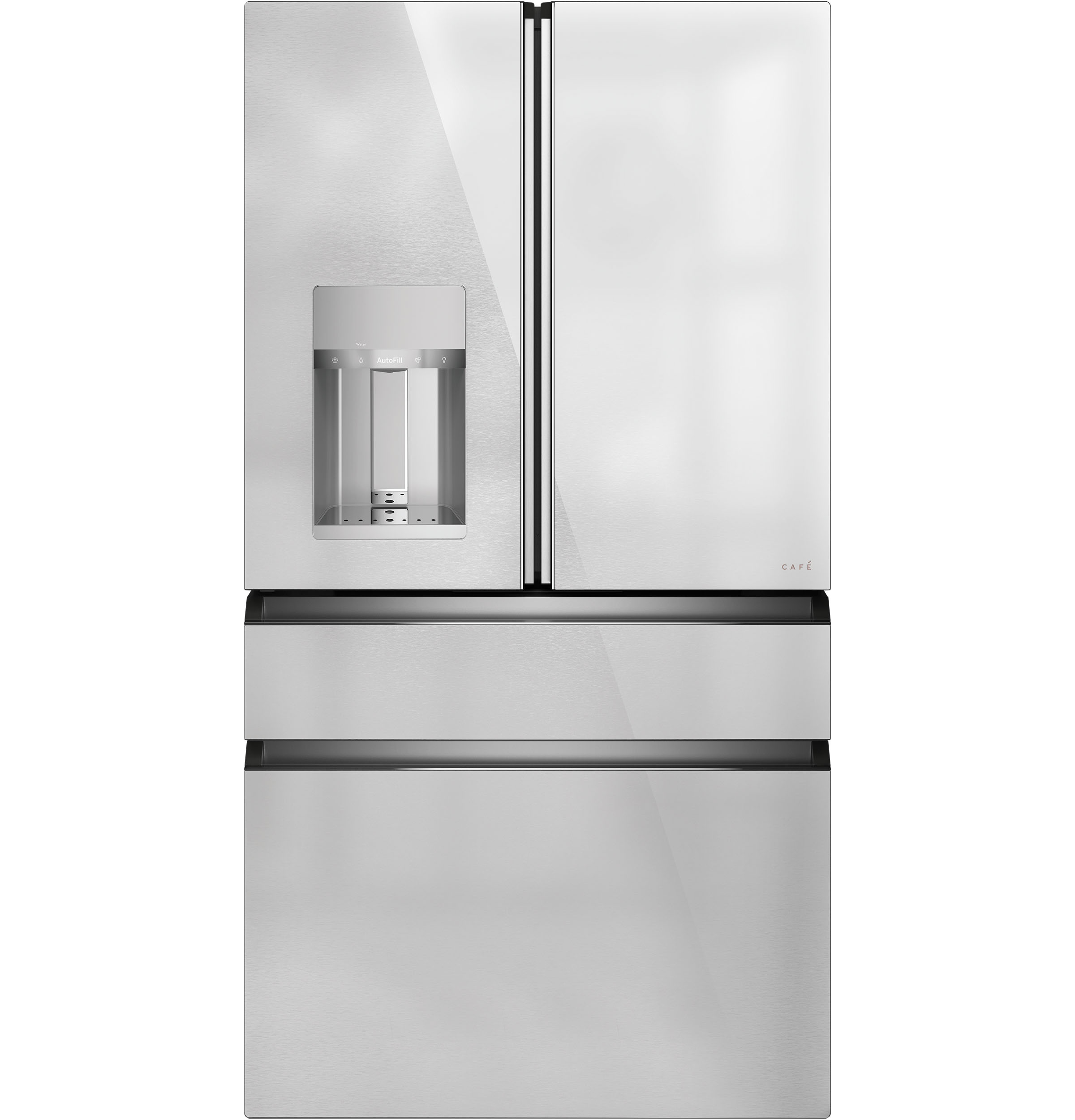
Stepping away from fancy screens, Cafe’s Platinum Glass model is one of the best smart refrigerator options if you’re looking for something with good connections but no reliance on built-in screens for performance. This is another four-door configuration, but make sure you have some extra room on each side because the doors swing out and might bump into the wall.
The interior is a standard design with a large upper compartment and two smaller, more flexible lower compartments. The handles for the lower compartments are set at the top of their doors for easy access, which is a nice touch for anyone who doesn’t want to bend down too much.
Smart features here include integration with Amazon Alexa and Google Assistant. Standard functions include notifying you if the internal temperature goes too high, while a triple evaporator system helps ensure this fridge maintains a great environment.
Some people might think this fridge is too expensive for one without a screen. It’s certainly on the lower end in intelligent functions, but it’s otherwise well-made and an excellent choice for buyers who want to have some smart integration rather than going all-in.
Pros:
- Solid four-door design
- Generally excellent build quality
- Integrates with apps that might add new features over time
Cons:
- Arguably a little overpriced
- No particularly unique features beyond excellent build quality
What To Look For- Smart Refrigerator Buying Guide
A fridge is a fridge, right? Well, if you’re looking for the best smart refrigerator, it’s a little more complicated than that. While the basic features are the same, things like door configuration, sensors, and connectivity options ultimately set these fridges apart from each other. Here’s what you should know before you go shopping for a fridge.
Door Configurations
Door configurations are perhaps the most significant thing that set fridges apart from each other, including smart fridges. Here are the most common options on the market.
Freezer On Top
This is the most popular option overall, though it’s surprisingly rare among smart fridges. They’re generally efficient and cost less to operate than some other models, which is a strong point in their favor.
Freezer on top models are usually quite wide, making it easy to store large items in them. Most have about 1/3 of their space as a freezer and the other 2/3 as fridge space. They work well if you want similar temperatures throughout but don’t have the same level of control as some other models.
Finally, these fridges usually require bending down to access the fridge area, which most people don’t like.
Freezer On Bottom
The obvious alternative to the most popular choice is the upside-down fridge, with the freezer on the bottom instead of the top. Unlike its more-popular cousin, which always uses doors, the freezer on bottom models usually has a pull-out drawer instead of a door that opens into shelves.
The main problem with this model is that it’s often hard to find and retrieve things from the freezer compartment. You have to stack vertically, so you’ll often end up bending down a lot to find anything. It’s also less organized than a freezer on top model. That’s fine if you only want to freeze a few things, but it’s a big deal if you tend to pack the compartment.
Side-By-Side
Side-by-side fridges are a relatively new alternative to the traditional freezer on top model. They have the same concept of one door for each of the two compartments, but the split in the fridge is vertical instead of horizontal.
These models are a good choice in a few situations, such as households with small kitchens. However, they also have smaller shelves than either of the previous two options and no way to store some larger items like pizzas.
Side-by-side fridges have about a 50:50 split of the fridge to freezer, although some may move towards 60:40 instead. The primary thing to note here is that they usually have more freezer space than the previous options.
Side-by-side fridges have drawbacks, but they also have something most other options don’t: the ability to place things in either the freezer or the fridge and retrieve them without bending down. You can store them on the same level, and that’s useful for people with specific mobility issues.
Most other fridges can’t offer that feature, so this can be a deciding factor for buyers.
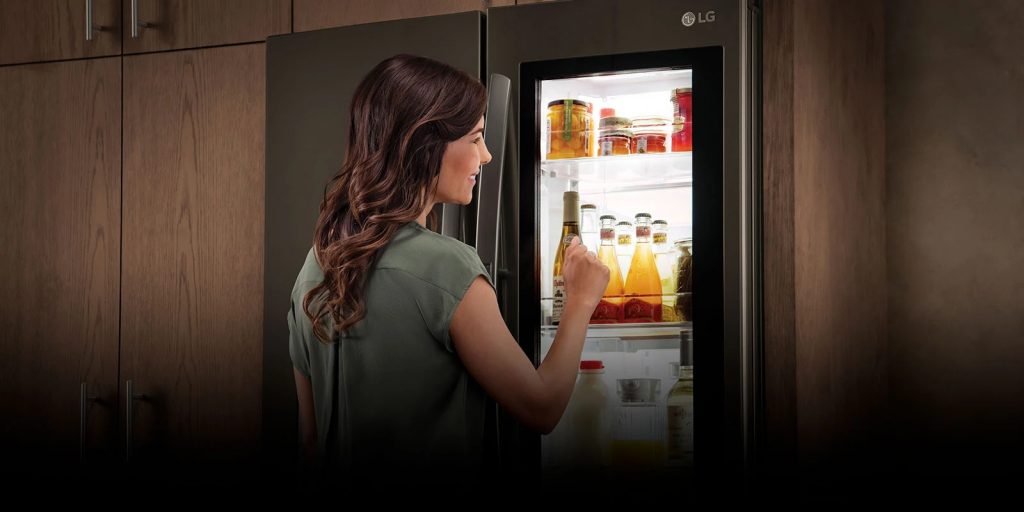
French Door
French door refrigerators have been around for a few decades now as an alternative to the freezer-at-bottom style. While almost entirely the same, it has two doors on top instead of one. This makes it easier to keep things cold and reach what you want, although the difference isn’t significant unless you’re opening the fridge regularly.
Many smart refrigerators use this style. It has several advantages, including having a clear split between a water/ice dispenser (nearly universal on smart fridges) on the left and a window or touchscreen on the right.
The freezer area is usually still a pull-out drawer with all the problems thereof, but if you don’t mind bending down, it can work well enough.
There’s also a variant of this setup with one or two doors for the top compartment, a wide, flat drawer you can configure the temperature for, and then a larger pull-out chamber below that. These fridges are surprisingly practical and may ultimately replace the regular French door style.
Four-Door
The latest configuration for smart refrigerators is a four-door style. These are similar to a French door, but swap the pull-out freezer compartment for two individual areas. Most fridges with this configuration set the lower left compartment as the freezer and the lower-right compartment as a flexible area with 4-5 settings. It can be a freezer, but it can also expand the fridge.
This setup is nice because it offers an impressive amount of versatility. You can put things you want to access at the top for convenience, while the lower area works well for things that need different temperatures from the primary fridge zone.
The four-door style also avoids the need to bend and stoop into a large drawer, making it more accessible for many people. The main drawback of this style is the lack of wide spaces in the freezer.
Most families do not store anything oversized in their freezer, but there’s no option at all for that here. If you need to freeze anything huge, you’ll want to get a traditional full-size freezer instead.
Smart Systems
What is a smart refrigerator, anyway? That may seem like a simple question, but the truth is that neither the market nor manufacturers have settled on a good definition for this yet. Some people think a fridge is only smart if it includes a touchscreen and apps, while other people consider it a smart device if it has app connectivity on their phones.
I’m not going to try and settle this issue today. It’s more likely that manufacturers will think up more systems to add to each fridge and that could heavily affect the overall development of these devices. Instead, let’s take a closer look at what systems you could see in a smart fridge.
Temperature Controls
Most fridges have temperature controls inside, but smart fridges can have a remote control for each of their sections. This isn’t something you’ll use often, but it’s a nice touch if you’re out of the house and want to modify things.
The primary use of this feature is for defrosting. If you have one compartment starting as frozen, you can change it to a warmer temperature and give something just enough time to defrost when you get home.
Smart fridges with touchscreens may also have temperature controls on the screen so you don’t have to reach inside and twist a knob.
Maintenance Alerts
This is arguably the most helpful feature for a smart fridge. Maintenance alerts can tell you if something isn’t working right so you can get it fixed as soon as possible. This can range from telling you the door’s been left open to significant system failures with parts like the cooler or the ice maker.
Most of the real power for these systems is in apps, which means the apps might provide more features over time. They can also help schedule maintenance visits and part orders with less fuss on your end, which is going to be a relief if you’ve ever had to deal with an unhelpful customer service team.
Viewpoints
These aren’t technically unique to smart fridges, but you rarely see them on other types. There are fundamentally two types of viewpoints you can get in a fridge, and most companies only install them in the upper right area.
The first type of viewpoint is an actual window. This is usually insulated glass, sometimes darkened when you’re not using it, stopping temperature loss while still providing a convenient look into the interior.
Manufacturers often refer to this as an easy access chamber. The chamber itself isn’t any different, but the ability to look inside the fridge without opening it can help reduce energy loss and keep things colder.
Fridges with touchscreens often have cameras into at least one compartment, and possibly all of them. This is the same as having a window, but the ability to display what’s in any of your fridge’s sections is fundamentally more helpful.
Ingredient Tracking
This is only common on the smartest fridges, so don’t expect to see it as a standard feature. An ingredient tracking system can use cameras inside the fridge to estimate how much of everything you currently have. If the fridge has a touchscreen, which it probably does with this feature, it can even find and suggest recipes using those ingredients.
Some models of fridges can also reorder ingredients you’re low on. This is most useful if there’s something you always want to keep in stock. Smarter systems will learn your habits and try to time things so you can order as infrequently as possible while still getting everything you need.
Smart Displays
Smart displays, normally touchscreens, are the hallmark of a high-end smart refrigerator. These are essentially oversized tablets, capable of installing apps, showing images, and maybe even talking over video chat.
This presents an immediate question, though: how much is too much when it comes to a smart display? Frankly, most people don’t want to spend too long standing in front of a fridge. It’s one thing if it’s for a special call during a family gathering, but stationary fridges don’t offer the convenience of portable devices.
However, they can provide helpful apps. On the simple end, you can use a smart display to show messages to people, like instructions for children to follow while they’re home alone. On the complex side, you can browse recipes or even use the display as a reference while you’re cooking to free up counter space.
Most smart displays don’t see nearly as much use as tablets and other devices, so they should last longer. However, expect repairs to be expensive if they’re not under warranty. It might be worth getting an extended warranty plan for a fridge with a smart display.
Spoilage Detection
This is a newer feature, but one we’ll probably see more of in the future. Notably, Amazon has a patent for a scent-based spoilage detector that can let you know when something inside is going bad. This is especially useful for items in the back of the fridge, where you might not notice them getting old.
Systems like these aren’t perfect. If something is hidden from cameras and kept in a package that prevents smells from getting through, even the smartest fridges can’t detect problems. Not yet, at least. Still, some help is better than none.
Surplus Food Purchases
This is more app-based and doesn’t necessarily require a fridge, though it can work through a fridge with a smart display. Companies like Electrolux and Karma are looking into stocking stores and refrigerators at home with food that would usually get thrown away.
Note that much of the food that’s thrown away is still good and will be for some time. This isn’t a way to feed people rotten food, but rather an option to use food that’s still plenty good and often of surprisingly high quality. On a wider scale, this can help reduce food waste and protect the environment.
Problems With Smart Fridges
Many people see smart refrigerators as the latest and greatest option in an industry that, frankly, hasn’t seen many advances in decades. There’s only so much you can innovate on a box with two or more cold sections without adding genuinely new technology.
The first problem with smart fridges is the price. Most start around $2000 for fairly bare-bones connectivity and features. You’ll probably pay $4000 or more for one with a good touchscreen, which is at least somewhat justified thanks to needing a whole computer’s worth of parts.
However, even with those components in mind, many people think smart fridges are currently overpriced. That puts them out of the reach for most regular consumers and fully into the category of luxury appliances.
You can expect repairs to be equally expensive, especially if techs need to replace complex electronics.
All of that is bad as it is, but smart fridges suffer from many of the same problems as regular models. They may have noisy fans, poor cooling systems, or other build issues that stop them from working as intended. Some manufacturers are more prone to errors, too.
In short, high prices don’t offer a guarantee of quality in most refrigerators. It’s one thing if you’re looking at a commercial-grade fridge because business owners have exceptionally high standards, but many smart fridges aren’t as reliable as they should be. That’s why it’s always better to look for a trusted name brand.
Finally, many smart fridges have comparatively short warranties, sometimes as little as one year for the main parts. The average fridge lasts 13 years, so that means warranties on smart fridges only cover a small portion of their life cycle.
Part of this may be because manufacturers don’t know how long their fridge will last yet, but it’s a striking limitation among even the best models. It’s usually worth getting at least a few years of extra warranty coverage for any smart fridge.
Best Smart Refrigerator-The Bottom Line
We like LG’s LRMVC2306S the best of the options above. It has the right balance of space, features, and price among smart refrigerators. It doesn’t have the same number of features as a high-end model, but it has enough to serve as an excellent introduction to this field.
Interesting Fact: Back in 2021’s shortage of electronic chips caused some decrease in supply of electronic devices for Smart fridges believe it or not.

